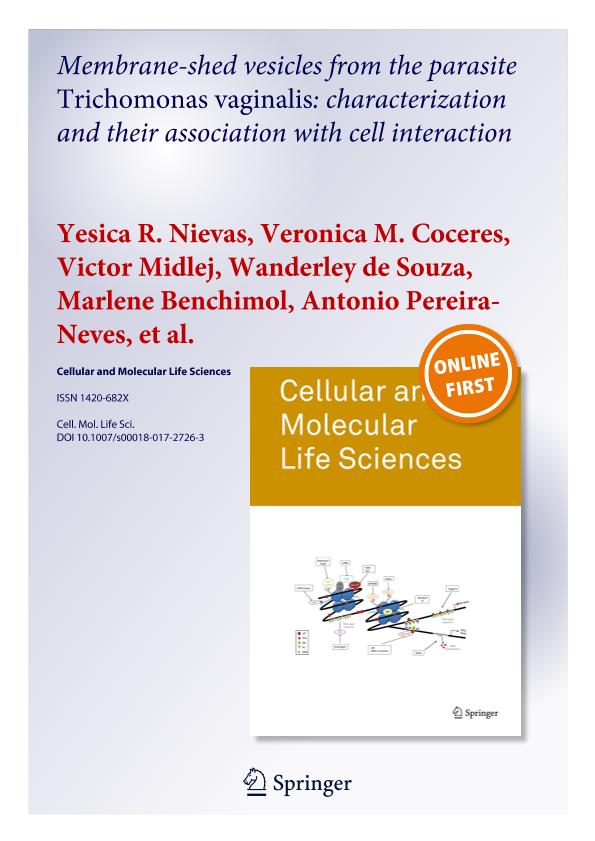Mostrar el registro sencillo del ítem
dc.contributor.author
Nievas, Yésica Romina

dc.contributor.author
Cóceres, Verónica Mabel

dc.contributor.author
Midlej, Victor
dc.contributor.author
de Souza, Wanderley
dc.contributor.author
Benchimol, Marlene
dc.contributor.author
Pereira Neves, Antonio
dc.contributor.author
Vashisht, Ajay A.
dc.contributor.author
Wohlschlegel, James A.
dc.contributor.author
Johnson, Patricia J.
dc.contributor.author
de Miguel, Natalia

dc.date.available
2018-06-22T22:34:57Z
dc.date.issued
2018-06
dc.identifier.citation
Nievas, Yésica Romina; Cóceres, Verónica Mabel; Midlej, Victor; de Souza, Wanderley; Benchimol, Marlene; et al.; Membrane-shed vesicles from the parasite Trichomonas vaginalis: characterization and their association with cell interaction; Springer; Cellular and Molecular Life Sciences; 75; 12; 6-2018; 2211-2226
dc.identifier.issn
1420-682X
dc.identifier.uri
http://hdl.handle.net/11336/49864
dc.description.abstract
Trichomonas vaginalis is a common sexually transmitted parasite that colonizes the human urogenital tract, where it remains extracellular and adheres to epithelial cells. Infections range from asymptomatic to highly inflammatory, depending on the host and the parasite strain. Despite the serious consequences associated with trichomoniasis disease, little is known about parasite or host factors involved in attachment of the parasite-to-host epithelial cells. Here, we report the identification of microvesicle-like structures (MVs) released by T. vaginalis. MVs are considered universal transport vehicles for intercellular communication as they can incorporate peptides, proteins, lipids, miRNA, and mRNA, all of which can be transferred to target cells through receptor–ligand interactions, fusion with the cell membrane, and delivery of a functional cargo to the cytoplasm of the target cell. In the present study, we demonstrated that T. vaginalis release MVs from the plasma and the flagellar membranes of the parasite. We performed proteomic profiling of these structures demonstrating that they possess physical characteristics similar to mammalian extracellular vesicles and might be selectively charged with specific protein content. In addition, we demonstrated that viable T. vaginalis parasites release large vesicles (LVs), membrane structures larger than 1 µm that are able to interact with other parasites and with the host cell. Finally, we show that both populations of vesicles present on the surface of T vaginalis are induced in the presence of host cells, consistent with a role in modulating cell interactions.
dc.format
application/pdf
dc.language.iso
eng
dc.publisher
Springer

dc.rights
info:eu-repo/semantics/openAccess
dc.rights.uri
https://creativecommons.org/licenses/by-nc-sa/2.5/ar/
dc.subject
Cellular Communication
dc.subject
Large Vesicles
dc.subject
Microvesicles
dc.subject
Parasite
dc.subject
Trichomonas Vaginalis
dc.subject.classification
Otras Ciencias Biológicas

dc.subject.classification
Ciencias Biológicas

dc.subject.classification
CIENCIAS NATURALES Y EXACTAS

dc.title
Membrane-shed vesicles from the parasite Trichomonas vaginalis: characterization and their association with cell interaction
dc.type
info:eu-repo/semantics/article
dc.type
info:ar-repo/semantics/artículo
dc.type
info:eu-repo/semantics/publishedVersion
dc.date.updated
2018-06-22T15:05:49Z
dc.identifier.eissn
1420-9071
dc.journal.volume
75
dc.journal.number
12
dc.journal.pagination
2211-2226
dc.journal.pais
Alemania

dc.journal.ciudad
Berlín
dc.description.fil
Fil: Nievas, Yésica Romina. Consejo Nacional de Investigaciones Científicas y Técnicas. Centro Científico Tecnológico Conicet - La Plata. Instituto de Investigaciones Biotecnológicas. Instituto de Investigaciones Biotecnológicas "Dr. Raúl Alfonsín" (sede Chascomús). Universidad Nacional de San Martín. Instituto de Investigaciones Biotecnológicas. Instituto de Investigaciones Biotecnológicas "Dr. Raúl Alfonsín" (sede Chascomús); Argentina
dc.description.fil
Fil: Cóceres, Verónica Mabel. Consejo Nacional de Investigaciones Científicas y Técnicas. Centro Científico Tecnológico Conicet - La Plata. Instituto de Investigaciones Biotecnológicas. Instituto de Investigaciones Biotecnológicas "Dr. Raúl Alfonsín" (sede Chascomús). Universidad Nacional de San Martín. Instituto de Investigaciones Biotecnológicas. Instituto de Investigaciones Biotecnológicas "Dr. Raúl Alfonsín" (sede Chascomús); Argentina
dc.description.fil
Fil: Midlej, Victor. Universidade Federal do Rio de Janeiro; Brasil
dc.description.fil
Fil: de Souza, Wanderley. Universidade Federal do Rio de Janeiro; Brasil
dc.description.fil
Fil: Benchimol, Marlene. Universidade Federal do Rio de Janeiro; Brasil
dc.description.fil
Fil: Pereira Neves, Antonio. Fundación Oswaldo Cruz; Brasil
dc.description.fil
Fil: Vashisht, Ajay A.. University of California at Los Angeles; Estados Unidos
dc.description.fil
Fil: Wohlschlegel, James A.. University of California at Los Angeles; Estados Unidos
dc.description.fil
Fil: Johnson, Patricia J.. University of California at Los Angeles; Estados Unidos
dc.description.fil
Fil: de Miguel, Natalia. Consejo Nacional de Investigaciones Científicas y Técnicas. Centro Científico Tecnológico Conicet - La Plata. Instituto de Investigaciones Biotecnológicas. Instituto de Investigaciones Biotecnológicas "Dr. Raúl Alfonsín" (sede Chascomús). Universidad Nacional de San Martín. Instituto de Investigaciones Biotecnológicas. Instituto de Investigaciones Biotecnológicas "Dr. Raúl Alfonsín" (sede Chascomús); Argentina
dc.journal.title
Cellular and Molecular Life Sciences

dc.relation.alternativeid
info:eu-repo/semantics/altIdentifier/url/https://link.springer.com/article/10.1007%2Fs00018-017-2726-3
dc.relation.alternativeid
info:eu-repo/semantics/altIdentifier/doi/http://dx.doi.org/10.1007/s00018-017-2726-3
Archivos asociados
